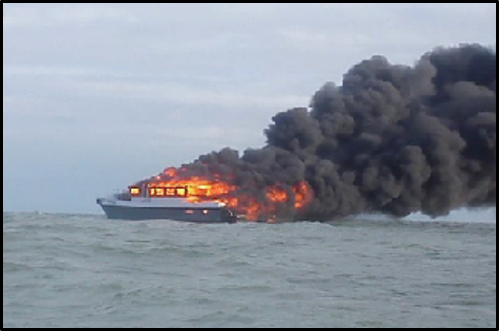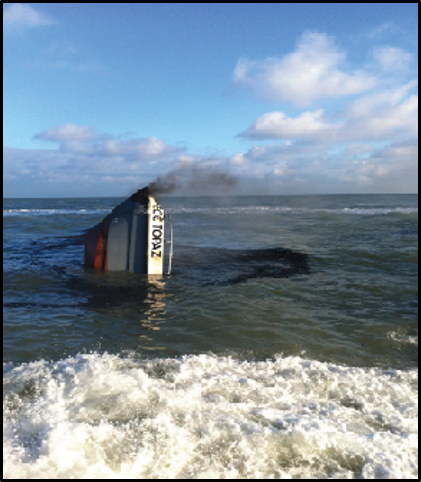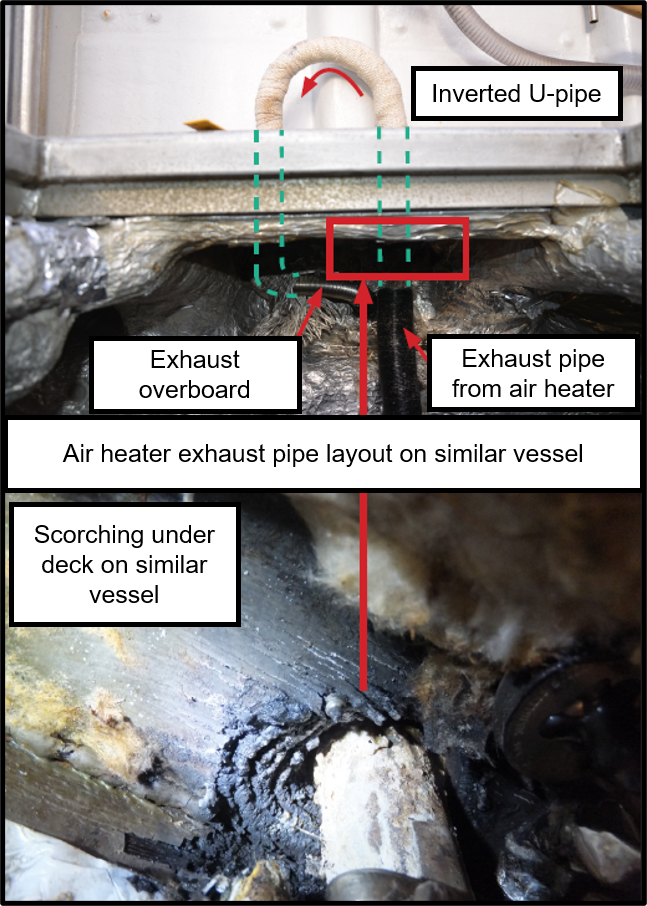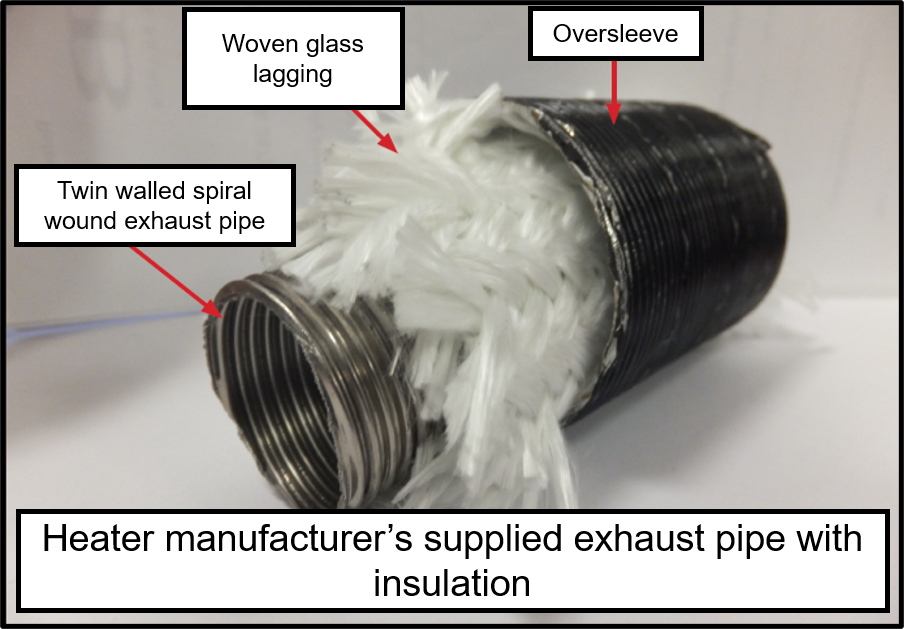-
What happened?
A 14m (46 ft) wind farm support catamaran caught fire 11nm from land.
The three crew members on the vessel were unable to extinguish the fire, which spread rapidly throughout its glass reinforced plastic structure, forcing them to abandon to a life raft. There were no passengers on board.
Once in the life raft, the skipper transmitted a ‘Mayday’ call using a hand-held radio and then activated a search and rescue transponder (SART).
The crew were winched from the life raft by helicopter and taken to a nearby hospital for treatment.
The fire continued unabated and the burnt vessel foundered in 33 m (108 ft) of water.

-
Why did it happen?
The most likely cause of the fire was an uninsulated section of the exhaust pipe from a diesel fired air heater.
- This was situated in a compartment in the starboard hull, directly under the wheelhouse, and ignited the plywood structure of the vessel.
As originally built, the exhaust pipe was insulated by woven glass lagging protected by an aluminium over sleeve to prevent the hot exhaust gases (≂450ºC) from heating the surrounding area.
Heater exhaust had been modified to route through a single walled, inverted U-pipe on the main deck to prevent sea water ingress from the exhaust overboard.
Where the exhaust piping had been re-routed through the main deck, the connection between the heater exhaust pipe and the inverted U-pipe was insulated. Consequently, the uninsulated section of the hot exhaust pipe was in close proximity to plywood underside of the deck, causing charring.
Crew of similar workboats had observed charring to the underside of main decks, where they were penetrated by the exhaust pipes from air heaters.
Compartment where the heater was situated was not fitted with any fire detection of extinguishing systems and contained several flammable items.

-
What did they learn?
Uninsulated exhaust pipes will quickly reach the temperature of the exhaust gases and, when in close proximity to wood or other combustible material, the likelihood of a fire is very high.
Owners and operators of vessels are strongly advised to:
- Check that all exhaust pipes on their vessels are fully insulated and do not come close to combustible material.
- Fit fire/smoke detectors in enclosed spaces where diesel-fired air heaters are installed.
- Avoid placing flammable material in compartments that contain potential heat sources.

-
Ask yourself or your crew
Are our exhaust pipes fully insulated? How do we know?
Why do you think the pipe was modified and not correctly insulated?
How can we ensure modifications are safe?
In the event of a fire, what do we have in place to ensure the safety of our crew?

Add to homescreen
Content name
Select existing category:
Content name
New collection
Edit collection
What happened?
A 14m (46 ft) wind farm support catamaran caught fire 11nm from land.
The three crew members on the vessel were unable to extinguish the fire, which spread rapidly throughout its glass reinforced plastic structure, forcing them to abandon to a life raft. There were no passengers on board.
Once in the life raft, the skipper transmitted a ‘Mayday’ call using a hand-held radio and then activated a search and rescue transponder (SART).
The crew were winched from the life raft by helicopter and taken to a nearby hospital for treatment.
The fire continued unabated and the burnt vessel foundered in 33 m (108 ft) of water.

Why did it happen?
The most likely cause of the fire was an uninsulated section of the exhaust pipe from a diesel fired air heater.
- This was situated in a compartment in the starboard hull, directly under the wheelhouse, and ignited the plywood structure of the vessel.
As originally built, the exhaust pipe was insulated by woven glass lagging protected by an aluminium over sleeve to prevent the hot exhaust gases (≂450ºC) from heating the surrounding area.
Heater exhaust had been modified to route through a single walled, inverted U-pipe on the main deck to prevent sea water ingress from the exhaust overboard.
Where the exhaust piping had been re-routed through the main deck, the connection between the heater exhaust pipe and the inverted U-pipe was insulated. Consequently, the uninsulated section of the hot exhaust pipe was in close proximity to plywood underside of the deck, causing charring.
Crew of similar workboats had observed charring to the underside of main decks, where they were penetrated by the exhaust pipes from air heaters.
Compartment where the heater was situated was not fitted with any fire detection of extinguishing systems and contained several flammable items.

What did they learn?
Uninsulated exhaust pipes will quickly reach the temperature of the exhaust gases and, when in close proximity to wood or other combustible material, the likelihood of a fire is very high.
Owners and operators of vessels are strongly advised to:
- Check that all exhaust pipes on their vessels are fully insulated and do not come close to combustible material.
- Fit fire/smoke detectors in enclosed spaces where diesel-fired air heaters are installed.
- Avoid placing flammable material in compartments that contain potential heat sources.

Ask yourself or your crew
Are our exhaust pipes fully insulated? How do we know?
Why do you think the pipe was modified and not correctly insulated?
How can we ensure modifications are safe?
In the event of a fire, what do we have in place to ensure the safety of our crew?

A catamaran caught fire. The crew evacuated and were later rescued. The fire was caused by uninsulated exhaust pipework passing through the hull.










